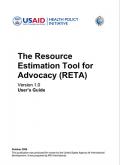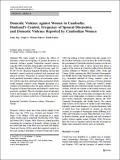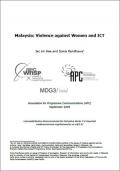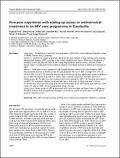What's New
Displaying results 4141 - 4150 of 4914

Data Sources, Data Uses: Identifying Gaps in HIV Data for Decision Making in the Asia-Pacific Region
Resource | Videos,
Data is critical to informed policies and focused programs on areas most at risk of increasing infections. The HIV/AIDS Data Hub was established to provide accurate, user-friendly access to information for evidence-based HIV programs in the Asia-Pacific region.

Resource | Presentations,
The Integrated Bio‐Behavioural Surveillance (IBBS) Survey 2009 presentation provides an estimate of HIV prevalence among three key populations at higher risk in Malaysia: Female Sex Workers, Transsexuals, and IV Drug Users. It also identifies sexual practices, injecting drug use practices within these groups and their relevant HIV knowledge, attitudes, and beliefs.

Resource | Presentations,
Presentation slides on the findings from the National Consensus Workshop 2009.

Resource | Fact Sheets,
In October 2009, there were 80 new HIV Ab seropositive individuals confirmed by the STD/AIDS Cooperative Central Laboratory (SACCL) and reported to the HIV and AIDS Registry (Table 1). This was a 36% increase compared to the same period last year (n=59 in 2008) and the highest number reported in a month. This brings the total for 2009 (January to October) to 629 cases.

Resource | Tools,
This Resource Estimation Tool for Advocacy (RETA) User’s Guide is a companion to RETA. RETA is a Microsoft Office Excel‐based tool that will help you calculate the resources you need to implement the Comprehensive Package of HIV Prevention Services for Men Who Have Sex with Men.

Resource | Publications,
This book begins with four case studies that examine how policing practices directly impact the lives of people who use drugs. Though the settings differ, the themes are similar: an approach to drug use that is primarily the responsibility of law enforcement officials rather than health care personnel results in corruption, abuses, and reluctance on the part of drug users to access even the most basic disease prevention services.

Resource | Publications,
This study sought to examine the effects of husband’s control and frequency of spousal discussion on domestic violence against Cambodian married women, using the 2005 Cambodia Demographic and Health Survey data. The sample included 1,707 married women, aged 16 – 49 (M=35.14). Structural Equation Modeling showed that husband’s control positively predicted both emotional and physical violence. Frequency of spousal discussion positively predicted emotional violence, an association consistent with the idea that a husband holding patriarchal beliefs would interpret women’s more frequent discussion as a violation of Cambodian norms for quiet, submissive wives.

Resource | Fact Sheets,
This is a report on cumulative HIV and AIDS situation of Nepal, as of Aswin 2066 (17 Oct 09).

Resource | Publications,
Information and communication technologies (ICT) are changing the ways women experience and confront violence. Despite this, there has been little attention paid to issues arising from the intersection of ICT and violence against women. The APC WNSP regards this intersection as a critical site of intervention both for women's rights activists and those working in the ICT development and policy arena. In this context, the APC WNSP commissioned the following overview paper as part of its 12-country project, "Strengthening women's organisations use of ICTs to end violence against women and girls" supported by the Dutch government's MDG3 Fund to promote gender equality and women's empowerment.
This country report highlights forms of violence against women that have received recognition in Malaysia and provides the context of ICT development and national policy objectives.

Resource | Publications,
The estimated HIV prevalence in Cambodia among adults aged 15–49 years declined from 2.0% in 1998 to 0.9% in 2006 (Ministry of Health Cambodia 2008). The number of people living with HIV ⁄ AIDS at the end of 2006 was a 61 400 (Ministry of Health Cambodia, NCHADS Surveillance Unit 2008; National AIDS Authority 2008). Since 2001, nongovernmental organizations (NGOs) have started pilot projects to deliver antiretroviral therapy (ART) and Cambodia has successfully applied for consecutive rounds of the Global Fund to fight AIDS, Tuberculosis and Malaria (GFATM). In the third quarter of 2007, more than 25,000 patients were receiving ART at 48 treatment sites, approaching 80% ART coverage (National AIDS Authority 2008).
This document aims to evaluate a 5-year HIV care programme (2003–2007) in the Sihanouk Hospital Center of HOPE, Phnom Penh, Cambodia.





